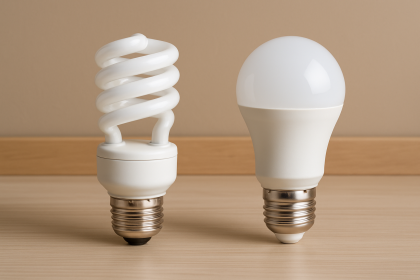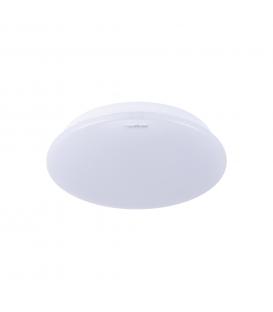CFL vs LED Lamps: Types, Benefits & Comparison

CFL stands for Compact Fluorescent Lamp. It is a type of energy-efficient lighting technology that uses fluorescent tubes to produce light. CFLs were designed as an improvement over traditional incandescent lamps, offering greater energy efficiency and longer lifespans.
Types of CFL Lamps:
- Spiral CFLs: These are the most common type of CFLs. They have a spiral-shaped design, which helps distribute light more evenly. They come in various wattages and color temperatures to suit different lighting needs.
- 2D CFLs: These lamps have a flat, square or rectangular shape and are often used in commercial settings. They provide a broader light distribution and are used for ceiling fixtures or wall-mounted fixtures.
Features of CFL Lamps:
- Energy Efficiency: CFLs use significantly less energy compared to traditional incandescent bulbs, resulting in lower electricity bills and reduced environmental impact.
- Long Lifespan: CFLs have a longer lifespan compared to incandescent bulbs, typically lasting around 8,000 to 15,000 hours.
- Color Temperature Variety: CFLs come in various color temperatures, allowing you to choose between warm, cool, or daylight-like lighting.
- Instant-On: While earlier CFLs had a brief delay in reaching full brightness, modern CFLs often have improved instant-on capabilities.
Benefits of CFL Lamps:
- Energy Savings: CFLs consume about 70-75% less energy than incandescent bulbs, leading to substantial energy cost savings over time.
- Reduced Heat Emission: CFLs produce less heat, making them safer to handle and reducing the load on cooling systems.
- Environmental Impact: CFLs produce fewer greenhouse gas emissions due to their lower energy consumption, contributing to a reduced carbon footprint.
Comparison with Equivalent LEDs:
Compact Fluorescent Lamps (CFLs) and Light Emitting Diodes (LEDs) are both energy-efficient lighting options, but there are differences between the two:
- Energy Efficiency: While CFLs are energy-efficient compared to incandescent bulbs, LEDs are even more efficient. LEDs use 75-80% less energy than incandescent bulbs, slightly more efficient than CFLs.
- Lifespan: LEDs generally have a longer lifespan than CFLs, typically lasting 25,000 to 50,000 hours or more. This is significantly longer than the lifespan of most CFLs.
- Instant-On and Flickering: LEDs have an instant-on capability, reaching full brightness immediately. Some older CFLs may have a short delay and occasional flickering, though this has been improved in recent CFL models.
- Mercury Content: CFLs contain a small amount of mercury, which is a hazardous material. While the amount is relatively low, it still raises concerns regarding disposal and potential environmental impact. LEDs do not contain mercury.
- Light Quality and Dimming: LEDs often provide better light quality and color rendering compared to CFLs. LEDs are also more compatible with dimmer switches, while dimmable CFLs can be harder to find.
- Temperature Sensitivity: CFLs can be sensitive to extreme temperatures, which can affect their performance. LEDs are generally more resilient in various temperature conditions.
- Initial Cost: CFLs are generally less expensive upfront compared to LEDs. However, considering the longer lifespan and greater energy savings of LEDs, they often offer a better long-term value.
In summary, while CFLs were a significant improvement over incandescent bulbs, LEDs have further advanced energy efficiency, lifespan, light quality, and environmental impact. When choosing between CFLs and LEDs, it's important to consider your specific lighting needs, budget, and preferences.






